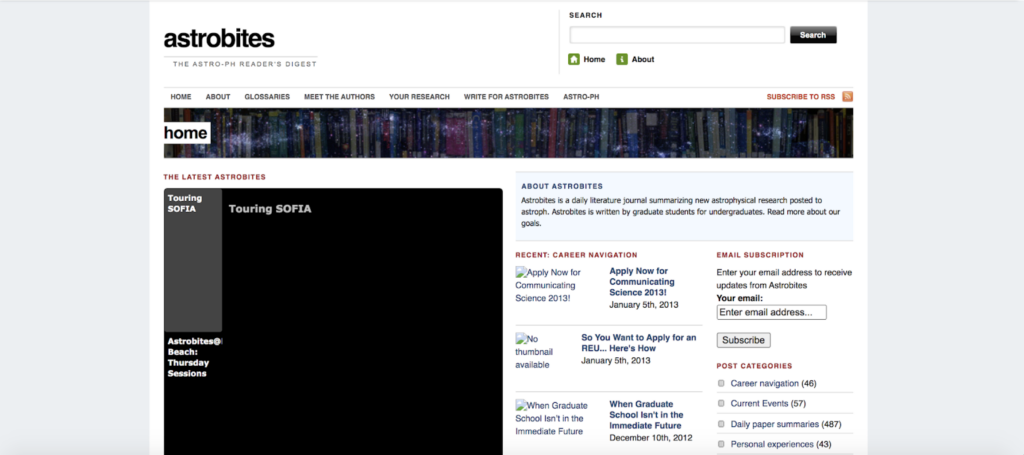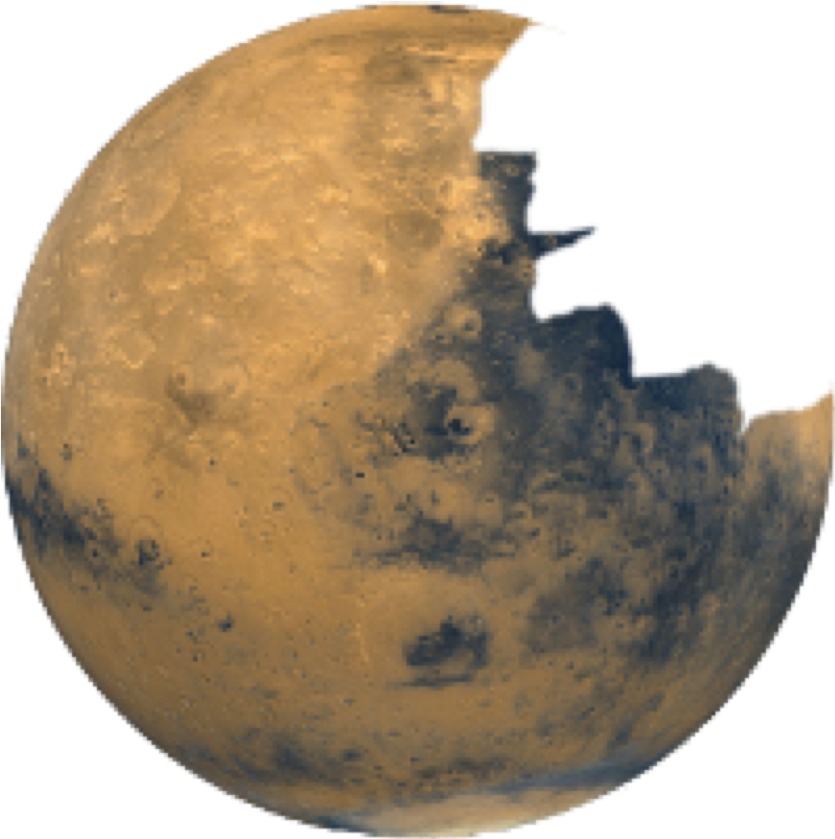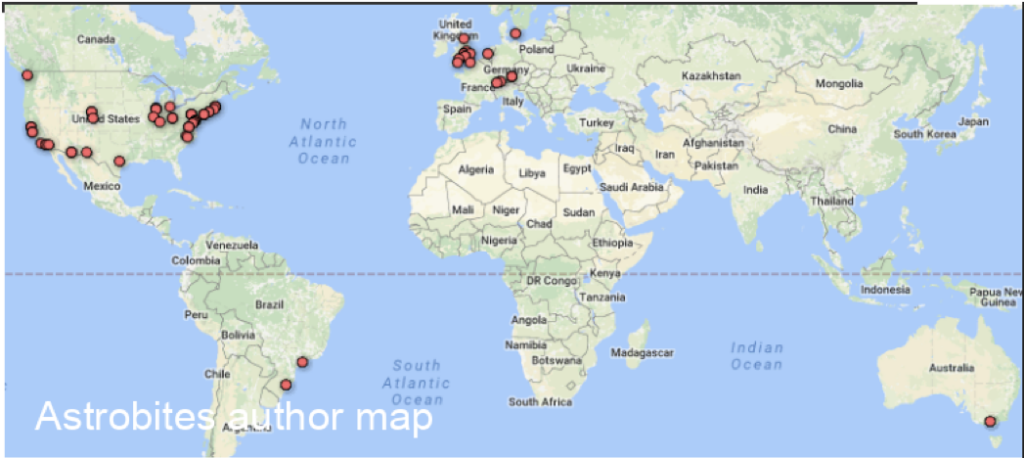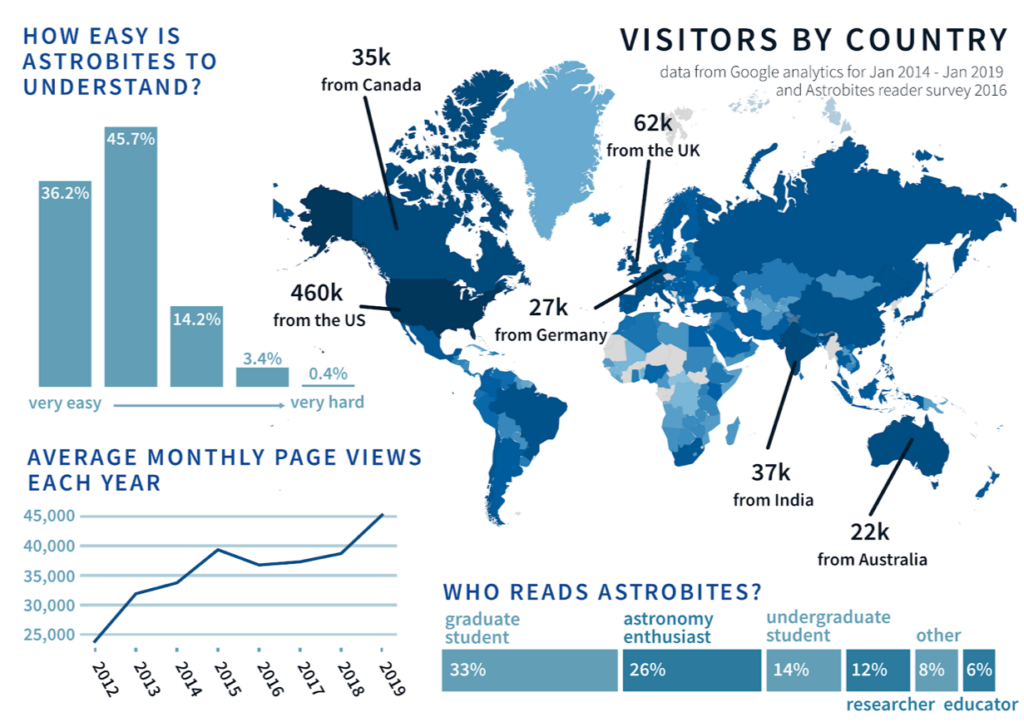Happy anniversary to us! Ten years ago, on November 30th 2010, Astrobites released its first article. Nearly every weekday since then, a new article was published on Astrobites. We have covered over 2,700 research papers from the ArXiv with the goal of summarizing the most recent astronomy research and making it available and accessible to undergrads and the public. In today’s post, we’d like to share with you the history of Astrobites.
–Fall Semester, 2010–
Astrobites started with a simple email, with the subject line “An idea for an outreach project”. The first team of astrobiters consisted of five first-year graduate students at Harvard: Nathan, Elisabeth, Ian, Courtney, and Katherine. We will highlight a few of the founders in tomorrow’s piece. Why did they start? To quote the original email, “there is a niche to be filled for undergrads interested in a career in research who want to know more about how the process works and prepare themselves for grad school.” There was a sense among the first authors that information about astronomy, both scientific journals and simpler things like ‘what is grad school?’ was not accessible to all. They took on the bold goal of posting an article every day.
–2011–
By April 2011, the Astrobites author collaboration had expanded to encompass more universities including University of Michigan, University of Colorado-Boulder, University of Arizona, and University of California at Santa Cruz. Starting January 4th of 2011, Astrobites joined Twitter. This is also the year that Kepler found the first exoplanet! The first Astrobite mentioning JWST was also published this year, noting a predicted launch date of 2014…and this is what our website looked like, by the way:

By the end of 2012, Astrobites had 676 articles published, and had started to include articles written by undergraduates describing their research. A call for new authors was first put forward to the world wide web during September of this year. The authorship started to expand into Europe, but the total number of authors was still just sixteen. By this time Astrobites had amassed a significant audience, with 214,713 total hits on the site for this year.
–2013–

By 2013, you’d be seeing our (now old) logo around. Can you tell what planet it is? It’s supposed to be Mars! By September 2013, Astrobites authors had written nearly 50 posts about navigating graduate school and careers for people with an astronomy background. Committees were formally organized at this point. Behind the scenes, Astrobites has always had committees running things such as editing bites, hiring new authors, managing the schedule, and an administrative committee overseeing everything generally. It was also determined at this point that authors would only serve for two years (which is still true today). Astrobites also attended its first American Astronomical Society, or AAS, meeting in 2013, presenting the outreach effort the site had made to the astronomy community. The first ComSciCon also happened in 2013, which was first organized by Astrobites and Chembites (Astrobites’ sister site from the very beginning, run by the partner of an astrobites founder <3).
–2014–
In 2014, Astrobites had 400,000 views, spanning 1,164 different articles. In August of 2014, the Rosetta mission visited comet 67P/Churyumov-Gerasimenko and became the first humanmade instrument to land on the surface of a comet. At the end of the year, we published our first major anniversary post looking back at the first four years of the site.
–2015–
Astrobitos, the Spanish version of Astrobites, was launched in 2015 by Astrobite author Elisa Chisari, marking this as the first Astrobite sister site in another language! This year also included the momentous New Horizons flyby of Pluto, which sent back the first detailed images of the dwarf planet and revealed it has a “heart.” March 2015 also marks the moment that Astrobites upgraded it’s look and became the website we know and love today:

–2016–
By 2016, nearly 80 graduate students had been involved with Astrobites, with alumni with jobs in academia, journalism, industry, and physics societies. Astrobites had also started an official relationship with the American Astronomical Society. We had some big science news to cover in 2016, too—the first detection of gravitational waves! After five years, Astrobites had grown to have 1.8 million total page views, 600,000 unique users, and on average 4,700 weekly readers. At this point there were seven total sister sites:

–2017–
In 2017, Astrobites started creating curricula for undergraduate and graduate courses. At the AAS conference in Grapevine, TX, Astrobite authors presented tools for astronomers and educators to use astrobites in the classroom. The resources within this workshop actually stem from a paper written by Astrobite authors published in 2012, and led to another paper on teaching with Astrobites that we of course summarized in an Astrobite. We still get undergraduate guest posts as an outcome of this shared curriculum. Astrobites, at this point, has also expanded its authorship to included a broader swath of the US, Europe, and had authors in Australia and South America. Astrobite author Ingrid Pelisoli launched Astropontos, the Portuguese version of Astrobites. The TRAPPIST-1 planets were also discovered in 2017!

–2018–
By 2018, Astrobites had 109 graduate students who had written ~2,000 articles over the past 8 years. Our audience by this point has expanded to encompass much of the world.


At this time, the AAS upgraded all of their logos, which meant we got to upgrade our logo too!
–2019–
In 2019 the podcast Astrosoundbites launched! You can find them on your favorite podcast app. Every ~2 weeks Will, Alex, and Malena talk about three astrobites about a specific topic, and they discuss the current state of that research. Be sure to check it out if you haven’t! In the science world, we were all wowed by the image taken of a black hole with the Event Horizon Telescope.
–2020–
And we’re back to the more familiar, 2020. While this has been a truly difficult time for many of our readers and authors, with the coronavirus outbreak, America finally starting to come to terms with a long history of racism, and political turmoil all over the world, Astrobites has strived to adapt and grow with the struggles its readers face. We are most proud of our participation in the #BlackInAstro series this year, and we look forward to more posts that go beyond summarizing the ArXiv. 2020 showed a time of tremendous growth for Astrobites. With a larger platform in the astronomy community, we will continue our mission to make astronomy more accessible to all.

Seeing how Astrobites has grown over the past decade is incredible, and we can’t wait to see where it goes in the future! Thank you all for being a part of this journey with us.
"Idea" - Google News
December 01, 2020 at 02:07AM
https://ift.tt/33ykwzv
An Idea For an Outreach Project | astrobites - Astrobites
"Idea" - Google News
https://ift.tt/2VWDFI5
https://ift.tt/3d3vX4n
Bagikan Berita Ini














0 Response to "An Idea For an Outreach Project | astrobites - Astrobites"
Post a Comment